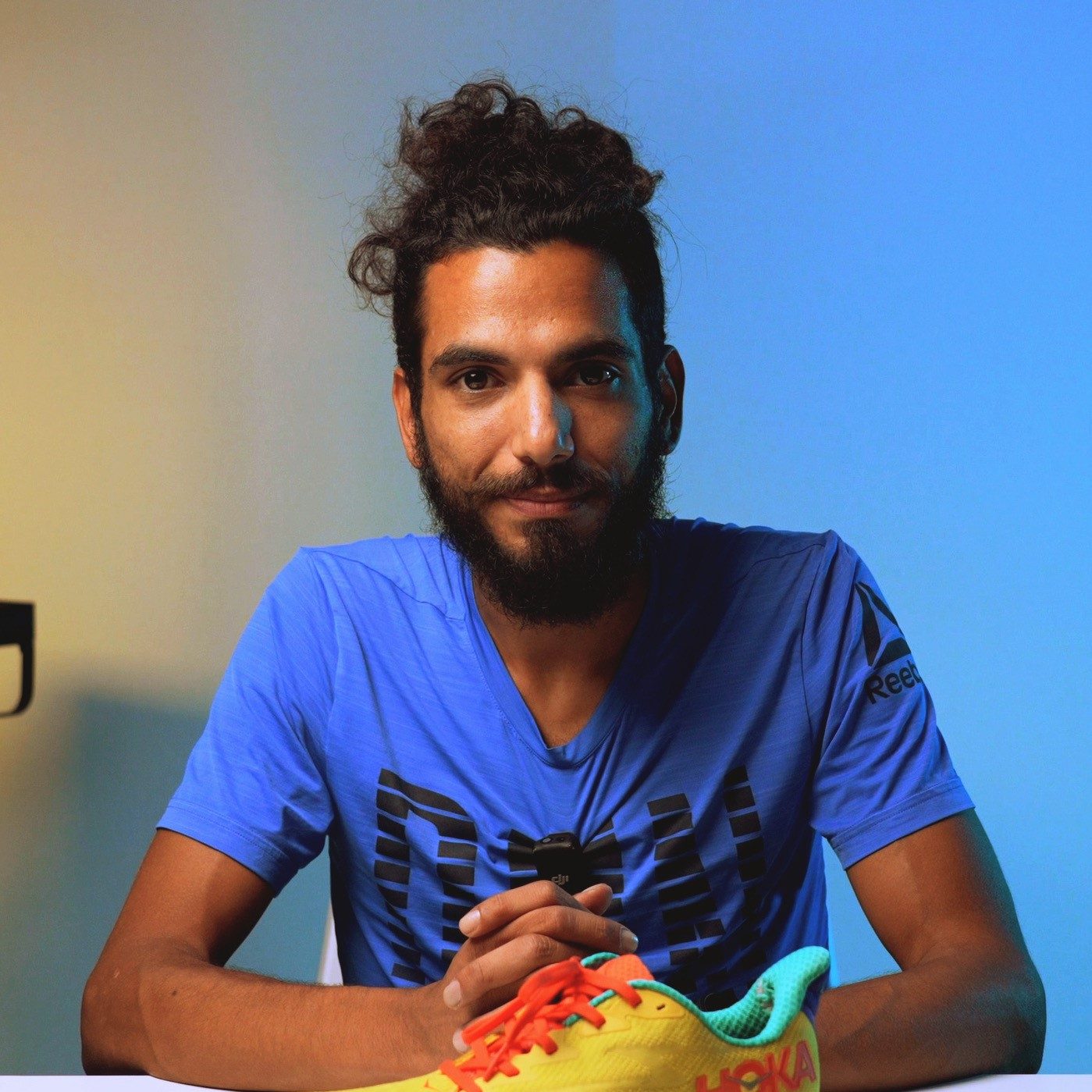Our verdict
Pros
- Tank-like foot protection
- Incredibly stable and supportive ride
- Excellent traction on mixed or rocky trails
- Great hiking/backpacking companion
- Relatively flexible despite 3D chassis
- Effectively dampens landings
- Generously padded and comfortable
- No chance of lace bite
- Durable and high-quality construction
- Eye-catching design
Cons
- A little heavy
- Stiff upper needs breaking in
- Cushioning on the firm side
- Not nimble enough for technical trails
Audience verdict
Comparison
The most similar running shoes compared
+ + Add a shoe | |||||
|---|---|---|---|---|---|
| Audience score | 75 Bad! | 88 Great! | 74 Bad! | 86 Good! | |
| Price | $140 | $160 | $90 | $100 | |
| Trail terrain | LightModerate | LightModerate | Light | Light | |
| Arch support | Stability | Neutral | Neutral | Neutral | |
| Weight lab Weight brand | 12.2 oz / 346g 11.4 oz / 323g | 11.4 oz / 322g 10.2 oz / 290g | 11 oz / 312g 11.5 oz / 326g | 9.9 oz / 282g 10.4 oz / 294.8g | |
| Drop lab Drop brand | 12.5 mm 11.0 mm | 6.2 mm 4.0 mm | 8.2 mm | 9.2 mm 8.0 mm | |
| Strike pattern | Heel | Mid/forefoot | HeelMid/forefoot | HeelMid/forefoot | |
| Size | True to size | True to size | True to size | True to size | |
| Midsole softness | Firm | Balanced | Balanced | Balanced | |
| Difference in midsole softness in cold | Small | Normal | Small | Big | |
| Toebox durability | Very good | Decent | Decent | Bad | |
| Heel padding durability | Decent | Good | Bad | Bad | |
| Outsole durability | Good | Decent | Good | Decent | |
| Breathability | Moderate | Breathable | Moderate | Moderate | |
| Width / fit | Wide | Medium | Narrow | Medium | |
| Toebox width | Medium | Medium | Medium | Wide | |
| Stiffness | Stiff | Stiff | Stiff | Stiff | |
| Torsional rigidity | Stiff | Stiff | Moderate | Moderate | |
| Heel counter stiffness | Stiff | Moderate | Moderate | Stiff | |
| Lug depth | 2.8 mm | 3.2 mm | 2.9 mm | 2.7 mm | |
| Heel stack lab Heel stack brand | 31.7 mm 28.0 mm | 32.8 mm 28.5 mm | 33.8 mm | 32.1 mm 30.0 mm | |
| Forefoot lab Forefoot brand | 19.2 mm 17.0 mm | 26.6 mm 24.5 mm | 25.6 mm | 22.9 mm 22.0 mm | |
| Widths available | NormalWide | Normal | NormalWideX-Wide | Normal | |
| Season | All seasons | SummerAll seasons | All seasons | All seasons | |
| Removable insole | ✓ | ✓ | ✓ | ✓ | |
| Orthotic friendly | ✓ | ✓ | ✓ | ✓ | |
| Ranking | #350 Bottom 5% | #137 Top 37% | #356 Bottom 4% | #179 Top 49% | |
| Popularity | #153 Top 42% | #347 Bottom 6% | #310 Bottom 16% | #259 Bottom 30% |
Who should buy
We recommend the Salomon XA Pro 3D v9 as an excellent choice for:
- Runners who prioritize foot protection and durability and want a tank-like shoe for those rocky trails.
- Outdoor enthusiasts looking for a trail runner that's versatile and supportive enough to double as a hiking shoe
- Overpronating or flat-footed runners who need a shoe with strong arch support and stability features that help maintain a more neutral stride.
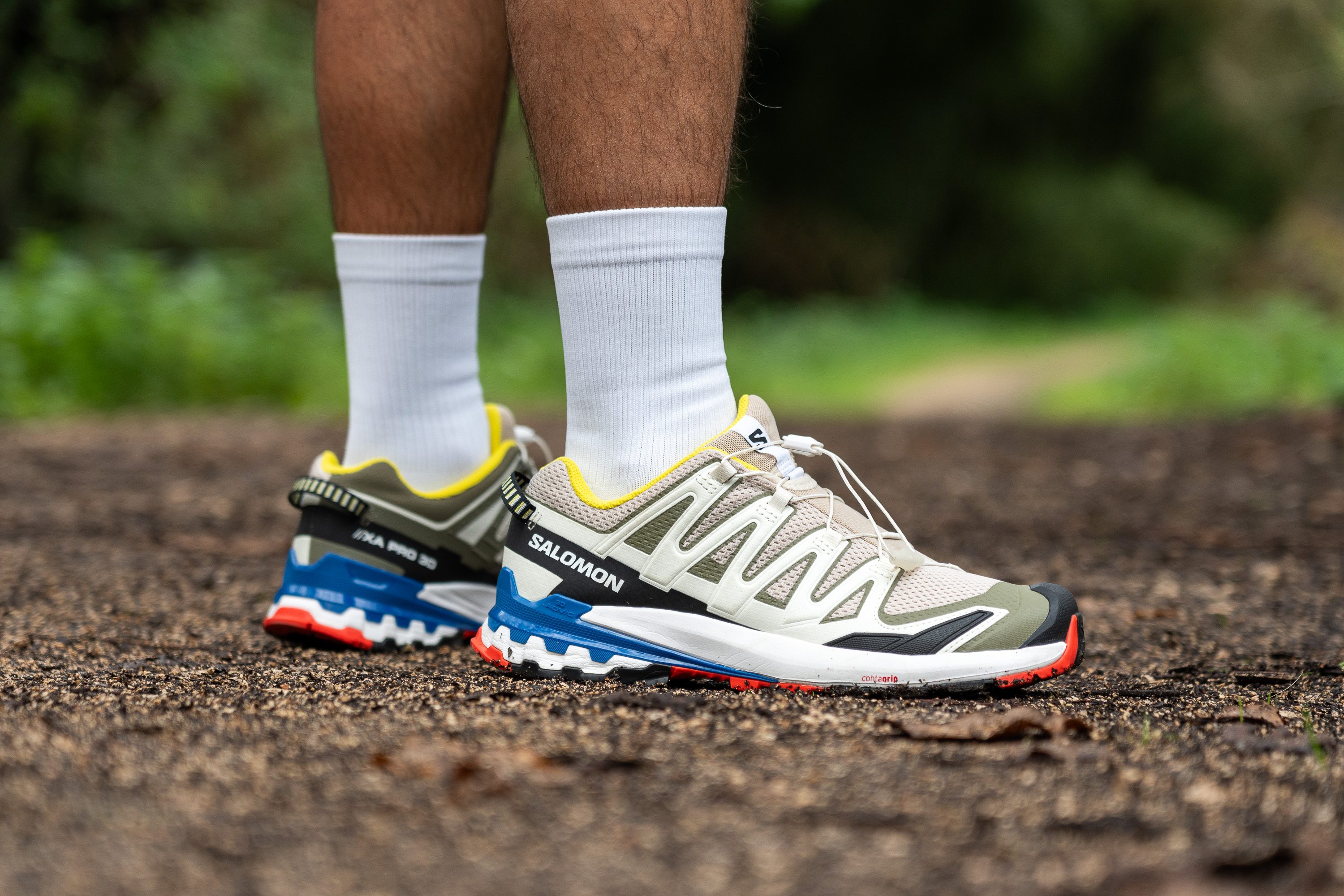
Who should NOT buy
With its stiff footbed and relatively subtle lug formation, the XA Pro isn't the ideal choice for tackling technical trails. Instead, we recommend looking into grippier alternatives like the Salomon Speedcross 6 or the Saucony Peregrine 13.
While it works well for our casual everyday runs, the XA Pro 3D v9 feels a little too firm and heavy underfoot as we push the mile markers on long-distance efforts. Runners looking for a lighter shoe with softer and more forgiving cushioning that can go ultra distances should consider the Salomon Ultra Glide 2 instead.

Those living in cold and wet climates in need of a shoe that will keep their feet dry in the event of rain or riverbed crossings should consider the waterproof version of this shoe, the Salomon XA Pro 3D v9 GTX, instead.
Cushioning
Heel stack
Using our caliper, we measured the XA Pro 3D v9's heel stack to be 31.7 mm thick. This is just shy of our current lab average and leaves heel strikers with more than enough foam underfoot to effectively dampen landing impact and mute out the harsh ground below.
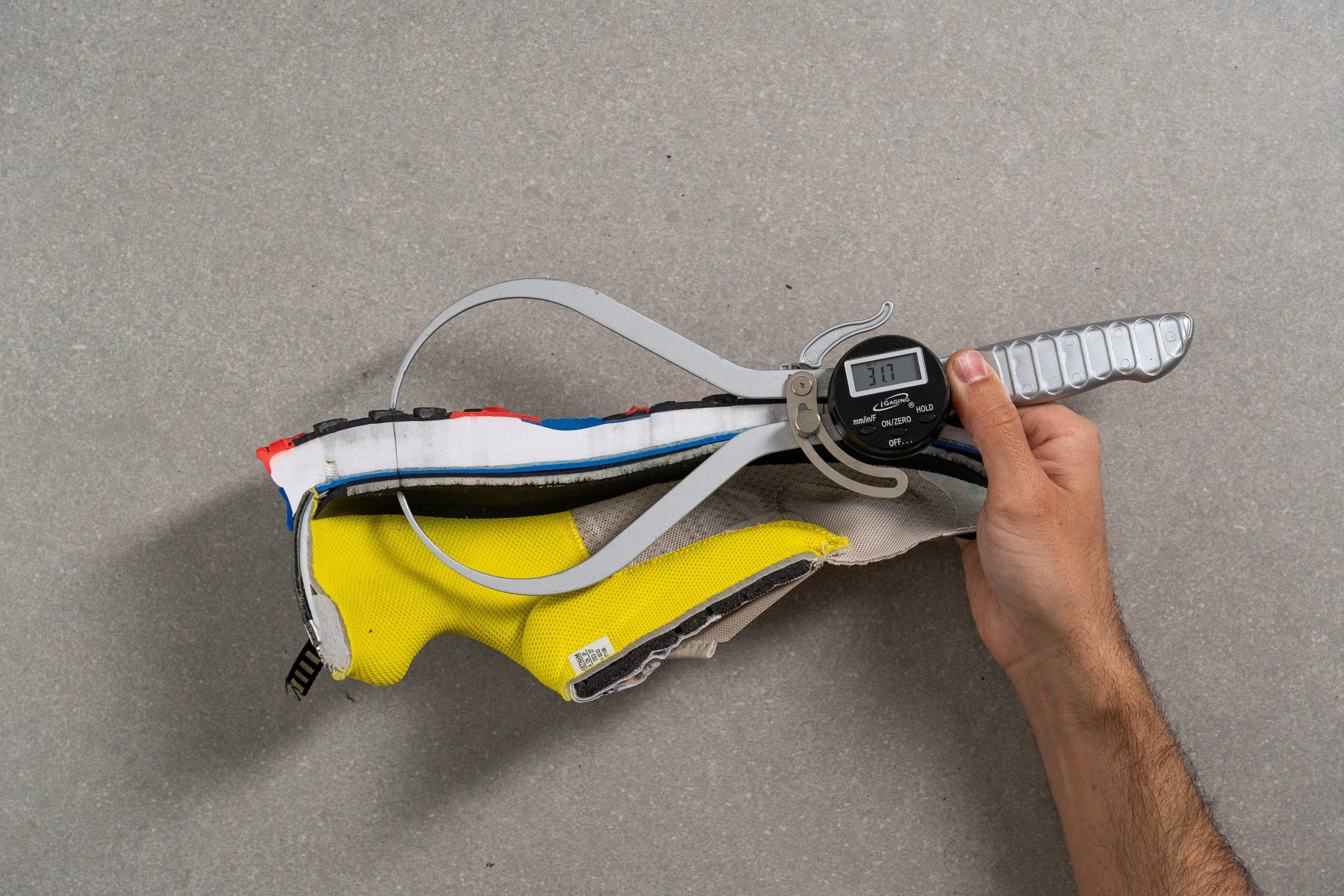
| XA Pro 3D v9 | 31.7 mm |
| Average | 32.6 mm |
Forefoot stack
The XA Pro 3D v9's forefoot stack is shorter than average at only 19.2 mm thick according to our caliper measurements. This affords forefoot strikers less foam to cushion their landings but should still be enough to comfortably facilitate easier runs over short to moderate distances. On the other hand, having such a low profile at the forefoot also gives us a good sense of the ground below for stable and intuitive toe-offs.

| XA Pro 3D v9 | 19.2 mm |
| Average | 25.1 mm |
Drop
The difference in our stack measurements leaves us with an offset of 12.5 mm, slightly higher than the 11 mm officially stated by Salomon. This discrepancy is too small to be significant for most as it still classifies the XA Pro 3D v9 as a high-drop shoe. This definitely favors a heel-striking gait as it promotes smoother heel-to-toe transitions with a healthy mix of cushioning and ground feel.

Forefoot-striking runners looking for a shoe with a less drastic offset that better suits their stride should consider the low-drop Salomon Thundercross or the Altra Paradigm 7 for those curious about a zero-drop experience.
| XA Pro 3D v9 | 12.5 mm |
| Average | 7.6 mm |
Midsole softness
Pressing our durometer against the XA Pro 3D v9's midsole foam yields a rather firm reading of 31 HA.
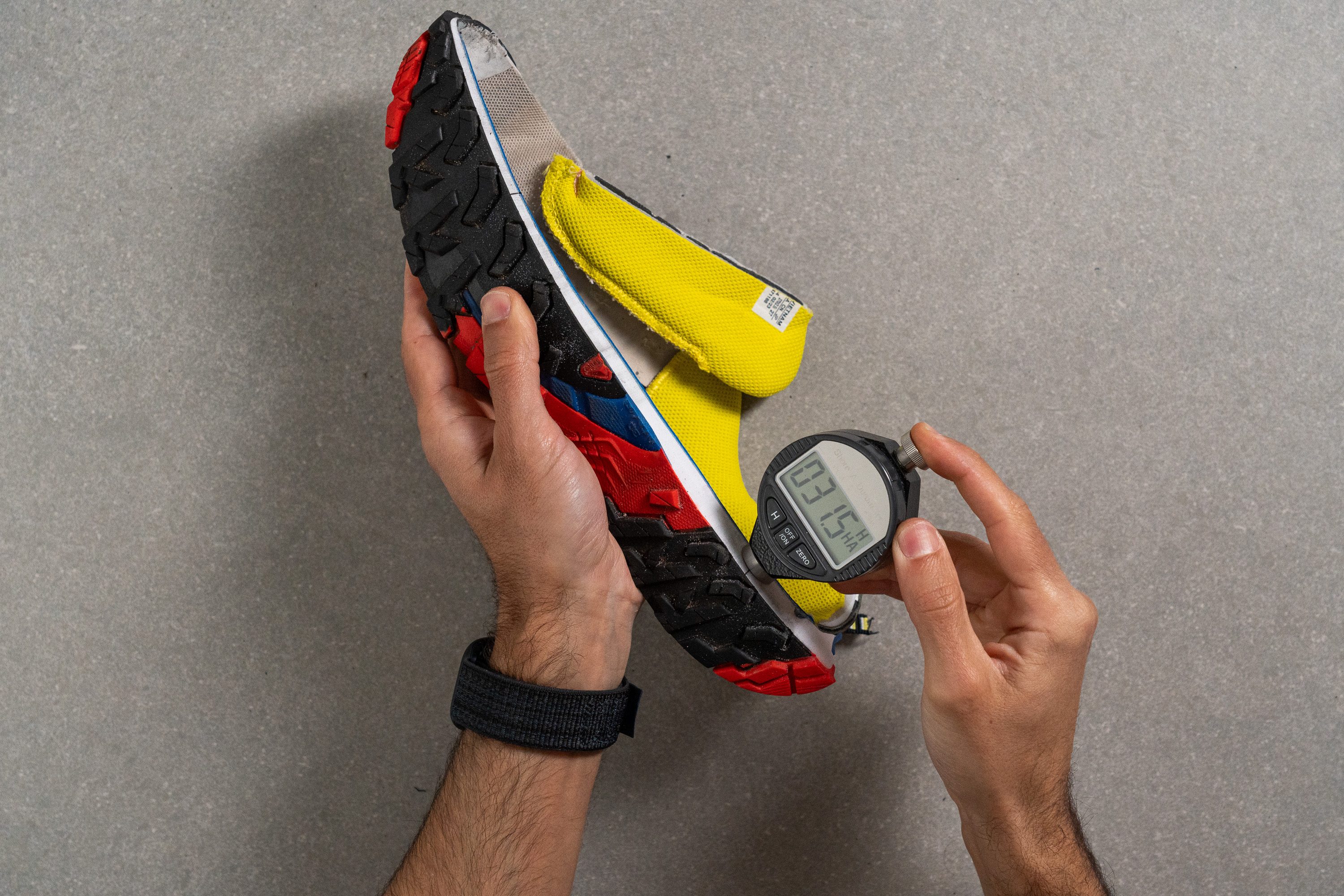
While having a firm midsole may not seem so appealing on paper, it does come with certain advantages, especially when running on hard, rocky trails. Chief among these is stability as the midsole isn't susceptible to twisting or contorting as we land on uneven surfaces. It also isn't at risk of bottoming out as it compresses under our weight which would make any underfoot obstacles feel uncomfortably apparent as we step on them. The lack of squishiness is also beneficial when shlepping around a heavy pack on hikes or backpacking adventures
That said, runners who prefer a softer ride should look into trail shoes with more plush midsoles like the positively pillowy ASICS Trabuco Max 2 or the incredibly responsive Hoka Speedgoat 5.
| XA Pro 3D v9 | 31.0 HA |
| Average | 21.9 HA |
Size and fit
Size
Salomon XA Pro 3D v9 fits true to size (54 votes).
Width / Fit
We measured the XA Pro 3D v9's to be 98.4 mm wide, which is broader than our current lab average.
This makes the XA Pro 3D v9 an accommodating option for most runners, except those with very narrow feet.

| XA Pro 3D v9 | 98.4 mm |
| Average | 95.6 mm |
Toebox width
Despite the wider-than-average measurement in our last section, the XA Pro 3D v9 might not be the best option for those with wide feet, as the toebox tapers more than the average trail shoe at 73.2 mm.
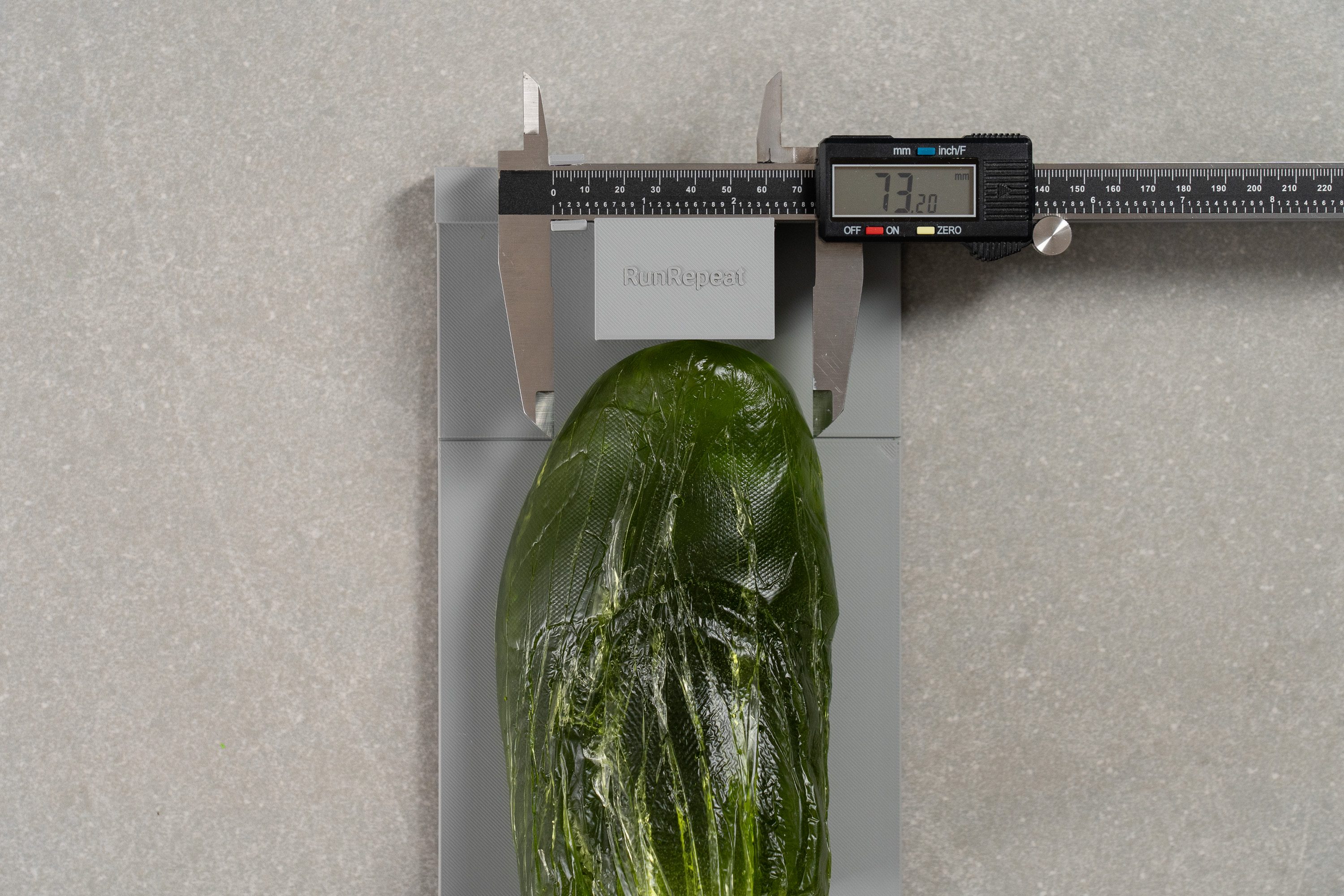
| XA Pro 3D v9 | 73.2 mm |
| Average | 74.6 mm |
Toebox height
On the flip side, the toebox offers impressive spaciousness with a generous 28.2 mm of height in the toe area, ensuring ample room for upward movement.

| XA Pro 3D v9 | 28.2 mm |
| Average | 27.0 mm |
Traction / Grip
Lug depth
The XA Pro 3D v9's lugs are quite subtle at only 2.8 mm thick according to our caliper measurements.
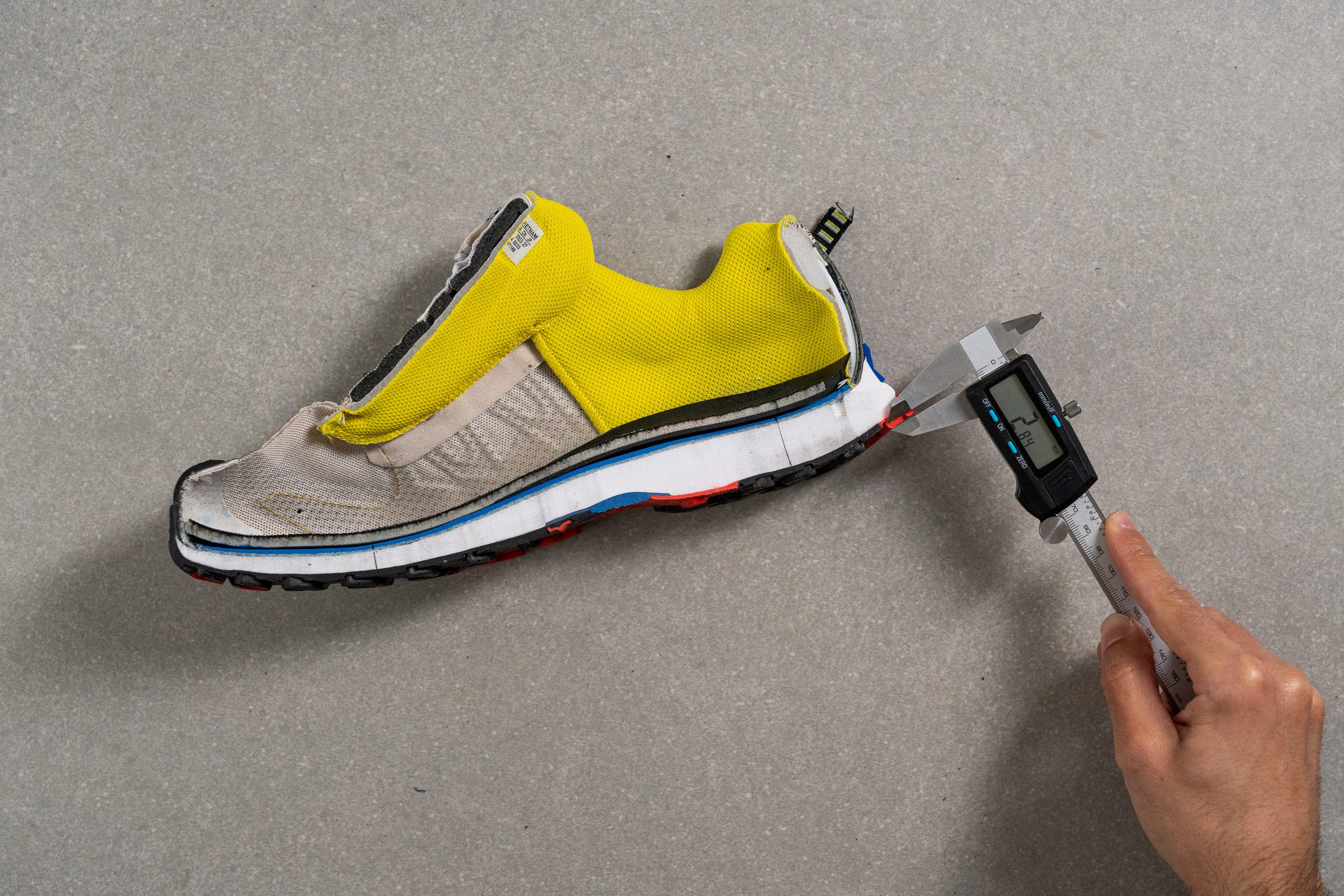
However, their grippy nature and multi-directional pattern provide great traction on mixed terrains and rocky surfaces, allowing us to power through the trails with confidence in every stride.
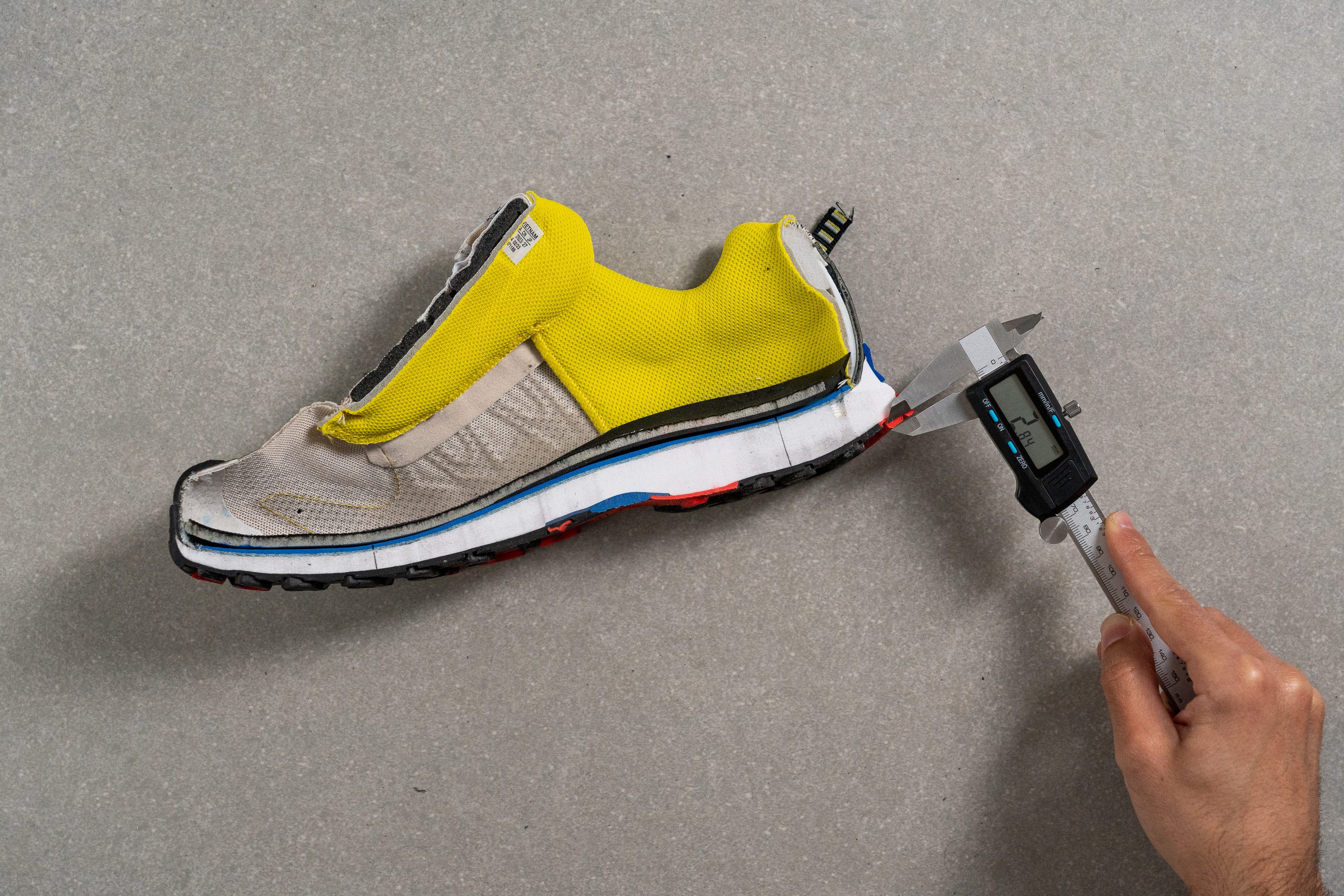
For more advanced trailheads in the market looking for a shoe with a more aggressive lug configuration that can comfortably tackle all manner of technical trails, we recommend looking into the Hoka Speedgoat 5 instead.
| XA Pro 3D v9 | 2.8 mm |
| Average | 3.5 mm |
Flexibility / Stiffness
As previously demonstrated, the XA Pro 3D v9's 3D chassis imparts a high level of torsional rigidity to the shoe, however, this doesn't seem to be the case with longitudinal stiffness. Securing the shoe to our workbench and, using a force gauge, we torqued the shoe to 90 degrees to find that only 23.8N of force was all that was needed. As such, the XA Pro 3D v9 is more flexible than the average trail shoe
This contributes to the shoe's comfortable ride as it is able to bend along with our foot with relative ease while still providing enough support to keep us going the distance and mitigate foot fatigue.
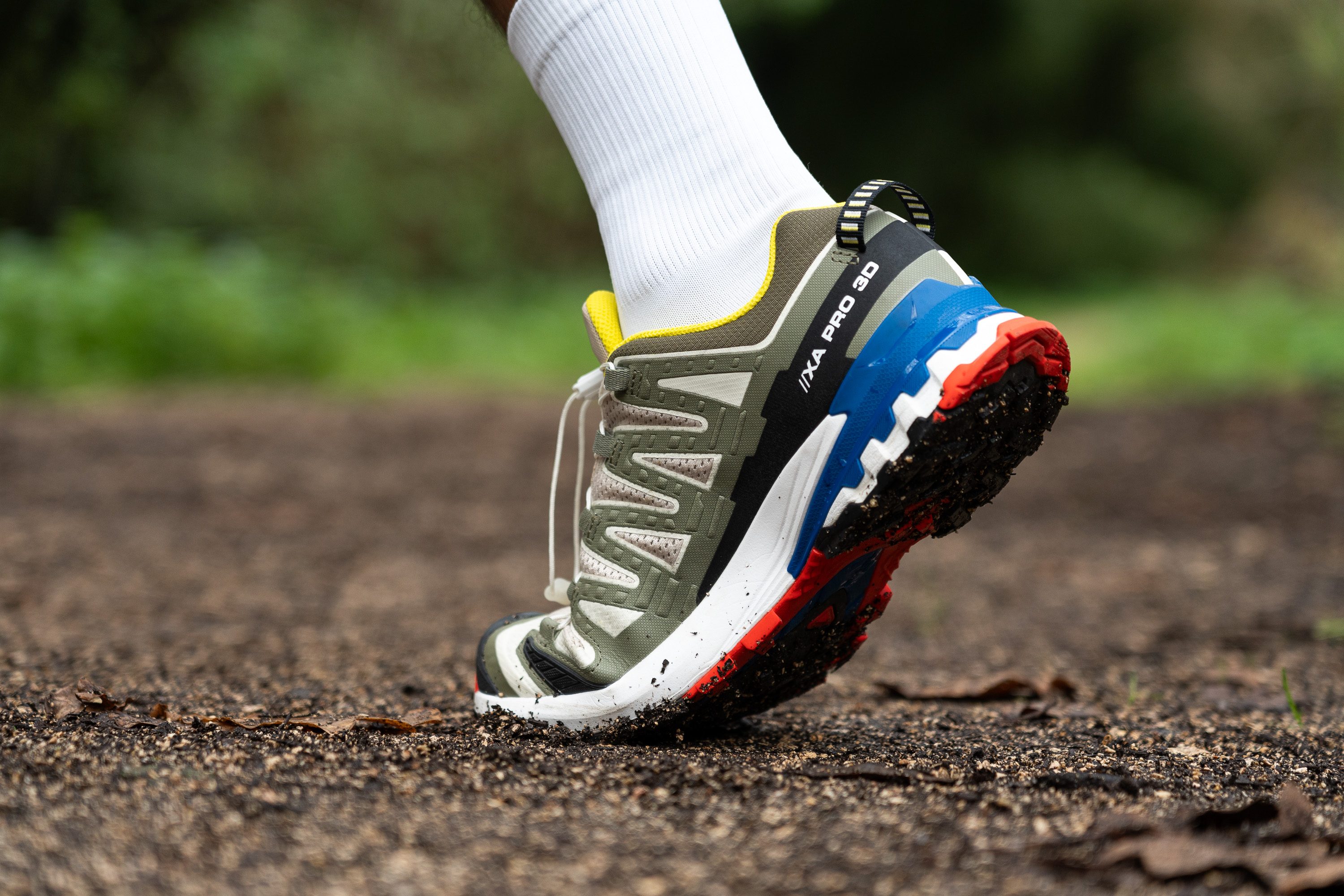
This test follows an older methodology, which is why you don't see recently tested shoes in the chart. Results from different methodologies can not be compared.
| XA Pro 3D v9 | 23.8N |
| Average | 27.1N |
Stiffness in cold

Stiffness in cold (%)
We also repeated the stiffness test after leaving the XA Pro 3D v9 in the freezer for twenty minutes and found that it became 48.9% stiffer once chilled. So while the midsole remains rather consistent between warm and cold conditions, the shoe will feel quite stiff and a little less forgiving on the foot come wintertime.
| XA Pro 3D v9 | 49% |
| Average | 32% |
Weight
The XA Pro 3D v9 could certainly use a diet. Weighing in at 12.2 oz (346g), it's is more akin to the average hiking shoe than the average trail shoe.
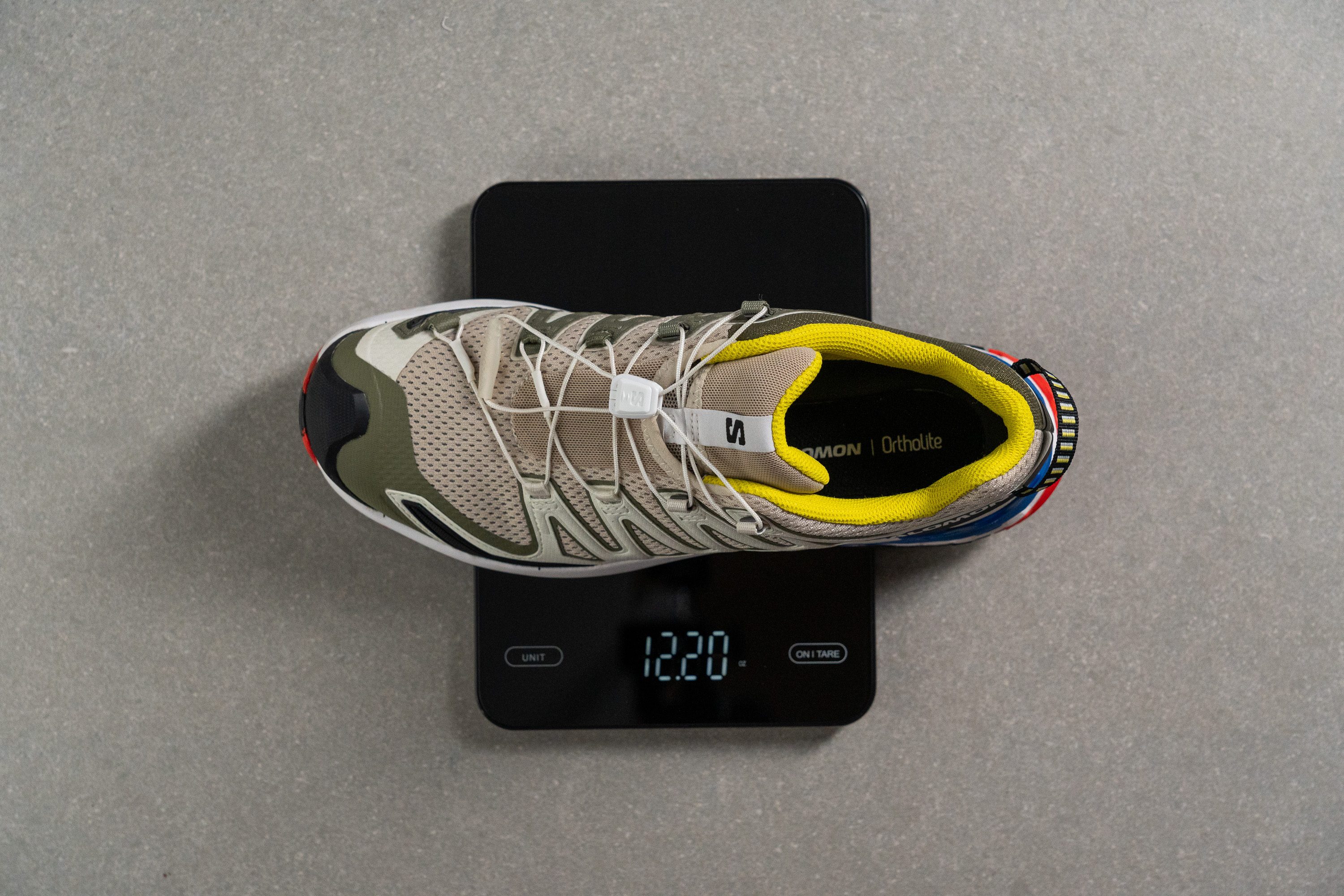
This wasn't too apparent or uncomfortable as we merrily jogged or walked our way through the trails on our easy days. However, it did prove more of an obstacle whenever we attempted to push the pace or challenge our stamina with long-haul days, especially when lots of ascents were involved. For those who prefer more lightweight trail shoes, we recommend the Hoka Challenger 7.
| XA Pro 3D v9 | 12.2 oz (346g) |
| Average | 10.2 oz (289g) |
Breathability
To test the breathability of the XA Pro 3D v9, we pumped smoke into the shoe in order to see how easily it vents through the upper. As the footage clearly demonstrates, the smoke almost immediately escapes through the toebox in plumes while very little makes it through the tongue.
The shoe's performance in our smoke test makes sense as we look at a backlit cross-section of its upper. The light shines through the single layer of unreinforced mesh at the toebox and along the lower lateral side of the shoe. The girthy tongue, however, is tucked beneath an external gusset of sorts, which forms a dense double layer that blocks out light and explains the more constricted airflow in those sections.
The overall breathability of the XA Pro 3D v9 is thanks to its airy upper mesh which, as our microscope images show, is made of rather loosely braided fibers woven to form regular perforations throughout the upper. As such, there are plenty of gaps for heat to escape and cool air to penetrate the shoe as we traipse along on warm days, keeping our feet fresh and stink-free.
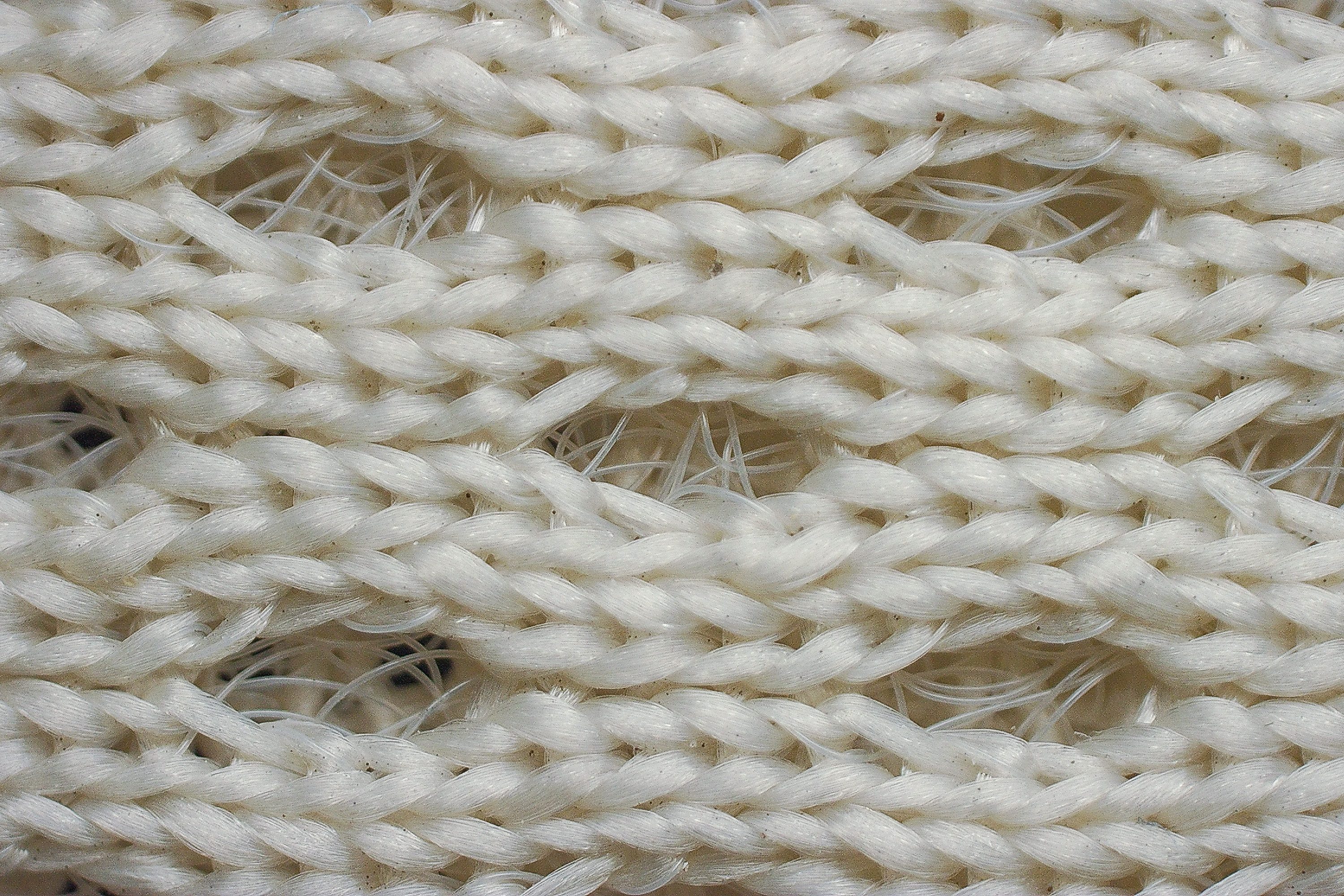
| XA Pro 3D v9 | 4 |
| Average | 3.2 |
Stability
Lateral stability test
Thanks in part to the 3D chassis technology, the XA Pro 3D v9 feels incredibly stable underfoot whether we sauntered, hustled, or skipped our way through the trails. This stability doesn't just impart a sense of confidence in our strides but also helps with energy efficiency as we aren't constantly making micro-adjustments to correct our balance.
As such, the XA Pro 3D v9 is a great option for overpronating runners who need a shoe that promotes a more neutral stride by mitigating excessive lateral movements of the foot.
Torsional rigidity
The aforementioned 3D chassis is made of a rigid, U-shaped piece of TPU embedded between the shoe's midsole and the outsole. This gives the shoe a high level of torsional rigidity, evidenced by our inability to bend and twist the shoe in our hands, which we scored 5 out of 5 on our subjective scale. This means that the shoe is extremely resistant to lateral movements and maintains a level base despite the contortions of our foot throughout our stride. This is extremely handy whenever we are traversing uneven terrain as it provides us with a stable landing surface
| XA Pro 3D v9 | 5 |
| Average | 3.6 |
Heel counter stiffness
Squeezing and pinching at the XA Pro 3D v9's well-structured heel counter reveals it to be quite stiff, earning a 4 out of 5 on our subjective scale.
We found that this level of rigidity in combination with the generous amount of heel padding effectively locks our rearfoot into the shoe. Not to mention, it provides a healthy mix of comfort and stability that keeps our ankles and tendons fresh and happy throughout our runs or hikes.
| XA Pro 3D v9 | 4 |
| Average | 3 |
Midsole width - forefoot
Using our caliper, we measured the XA Pro 3D v9's midsole to be 110.3 mm wide at the forefoot, putting it on par with the average trail shoe. This gives us a wide enough base to ensure stable forefoot landings and toe-offs while still feeling rather nimble on turns (as opposed to blocky).
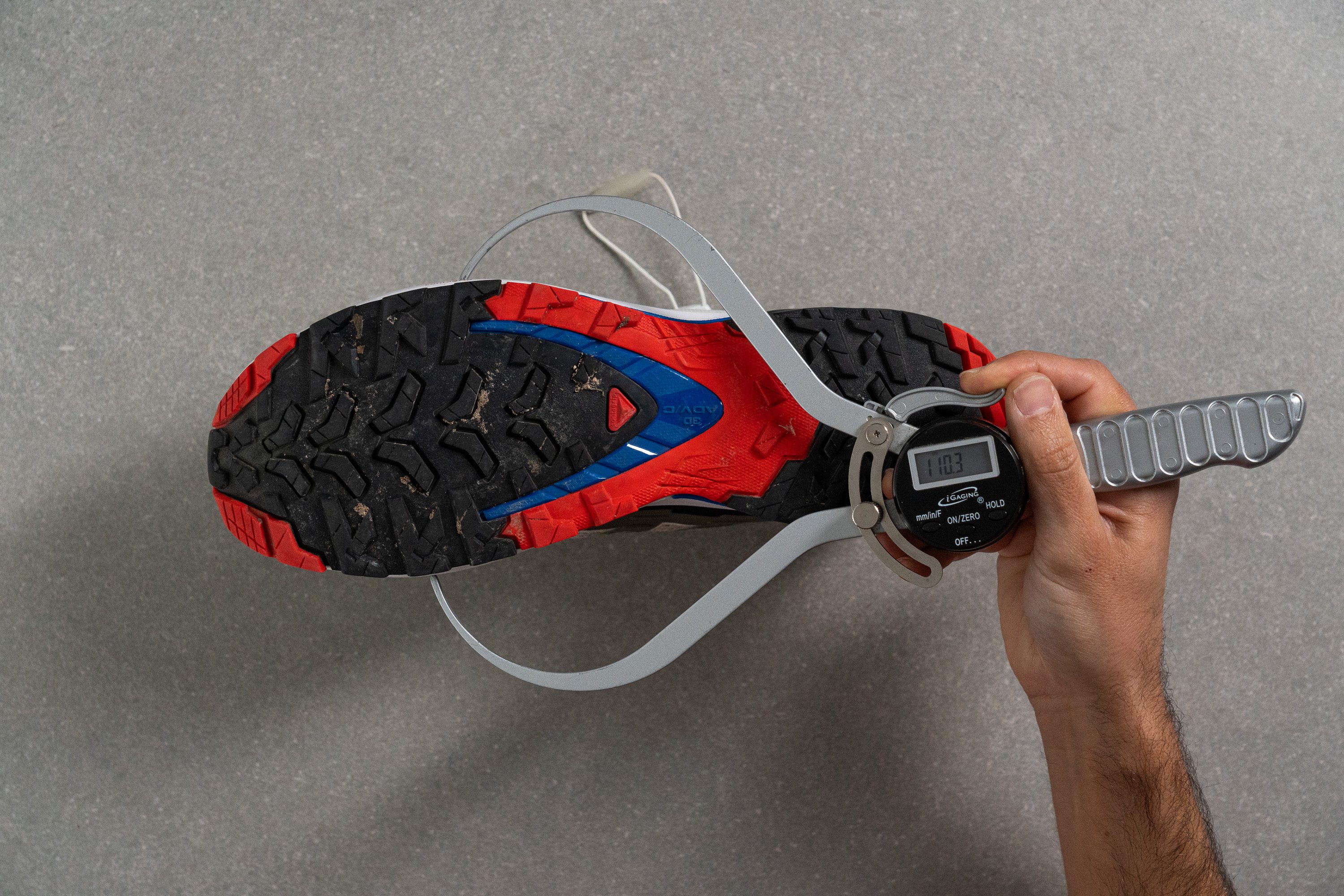
| XA Pro 3D v9 | 110.3 mm |
| Average | 112.8 mm |
Midsole width - heel
Back at the heel, the XA Pro 3D v9's midsole is quite a bit narrower than average at only 83.2 mm wide according to our caliper measurements.
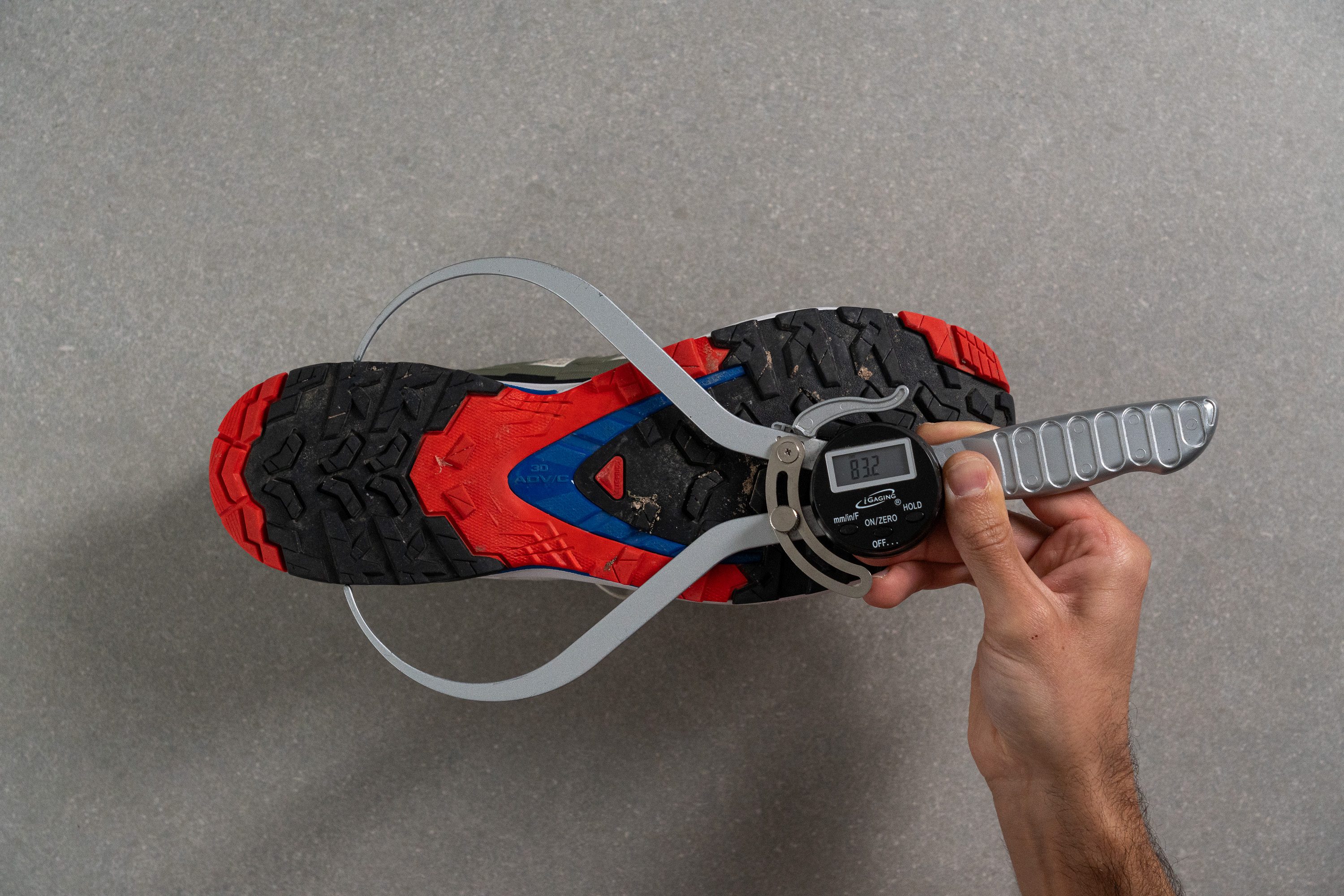
This further adds to the shoe's agile feeling underfoot which allows us to twist and turn on a dime as the trails get a little more technical. However, heel strikers more accustomed to having a more robust landing platform for their trial runs should consider alternatives like the Saucony Endorphin Rift or the Brooks Caldera 6.
| XA Pro 3D v9 | 83.2 mm |
| Average | 89.8 mm |
Durability
Toebox durability
To simulate extreme wear and tear, we fired up our trusty Dremel to 5K RPM and set it against the XA Pro 3D v9's rubberized toe bumper with 3.2N of force.
After four seconds of grinding, our tool wasn't able to do much beyond smooth out the criss-cross pattern, leaving only a small indent in its wake. This earns the XA Pro 3D v9 an impressive toebox durability score of 5 out of 5. As such, we don't need to worry about stubbing our toes or snagging the toebox on a branch while running in this hardy shoe.
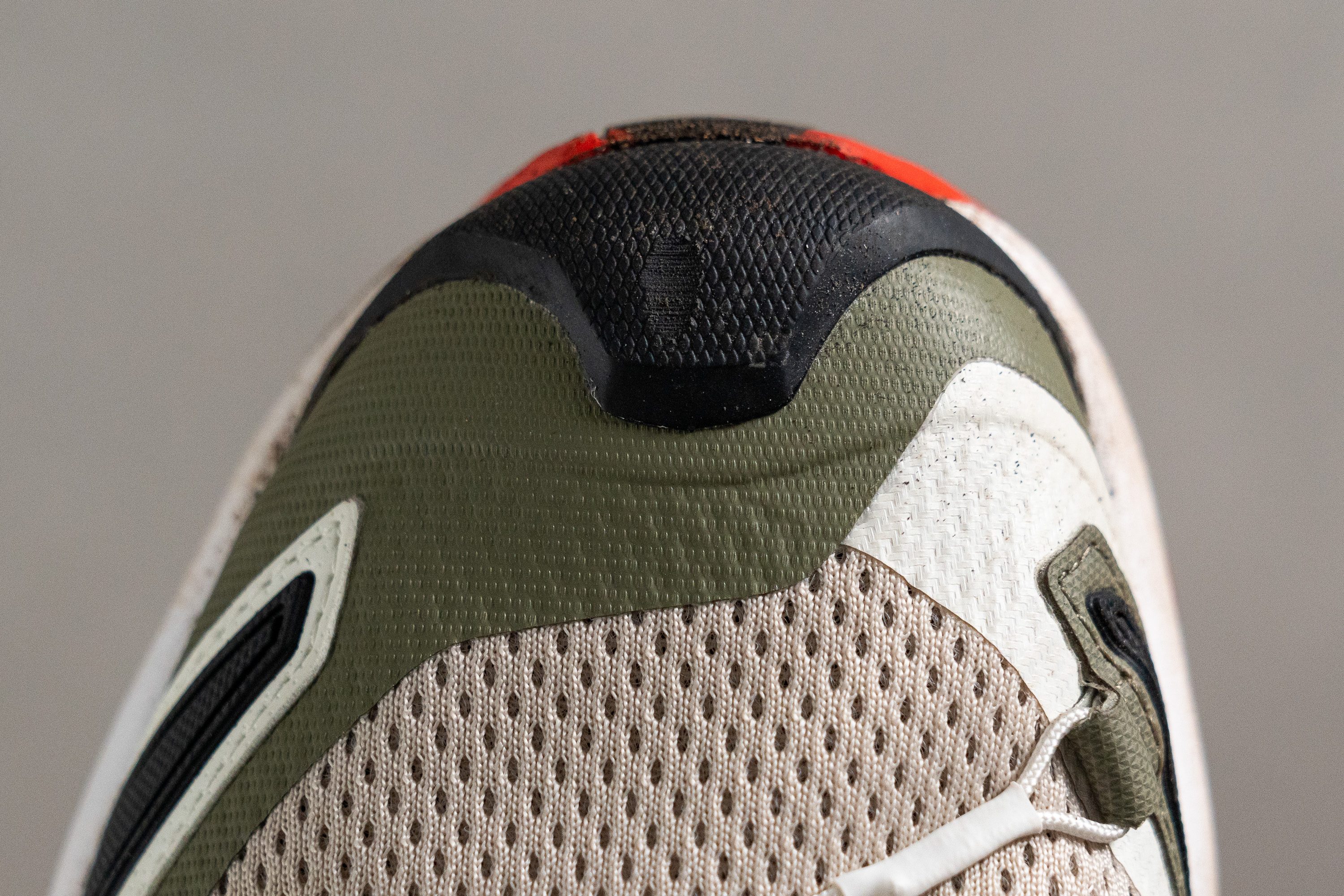
| XA Pro 3D v9 | 5 |
| Average | 3.1 |
Heel padding durability
Next, we turned our attention to the heel collar and set our Dremel against the shoe once more.
While it seemingly takes the beating quite well, upon inspecting the damage closely in the aftermath of the four-second test, we found that our tool had actually minced through the lining and managed to siphon out some of the internal padding. This leads us to give the XA Pro 3D v9 a less-than-impressive heel padding durability score of 2 out of 5. However, we don't see this being a major issue with normal use unless frequently going for sockless runs.
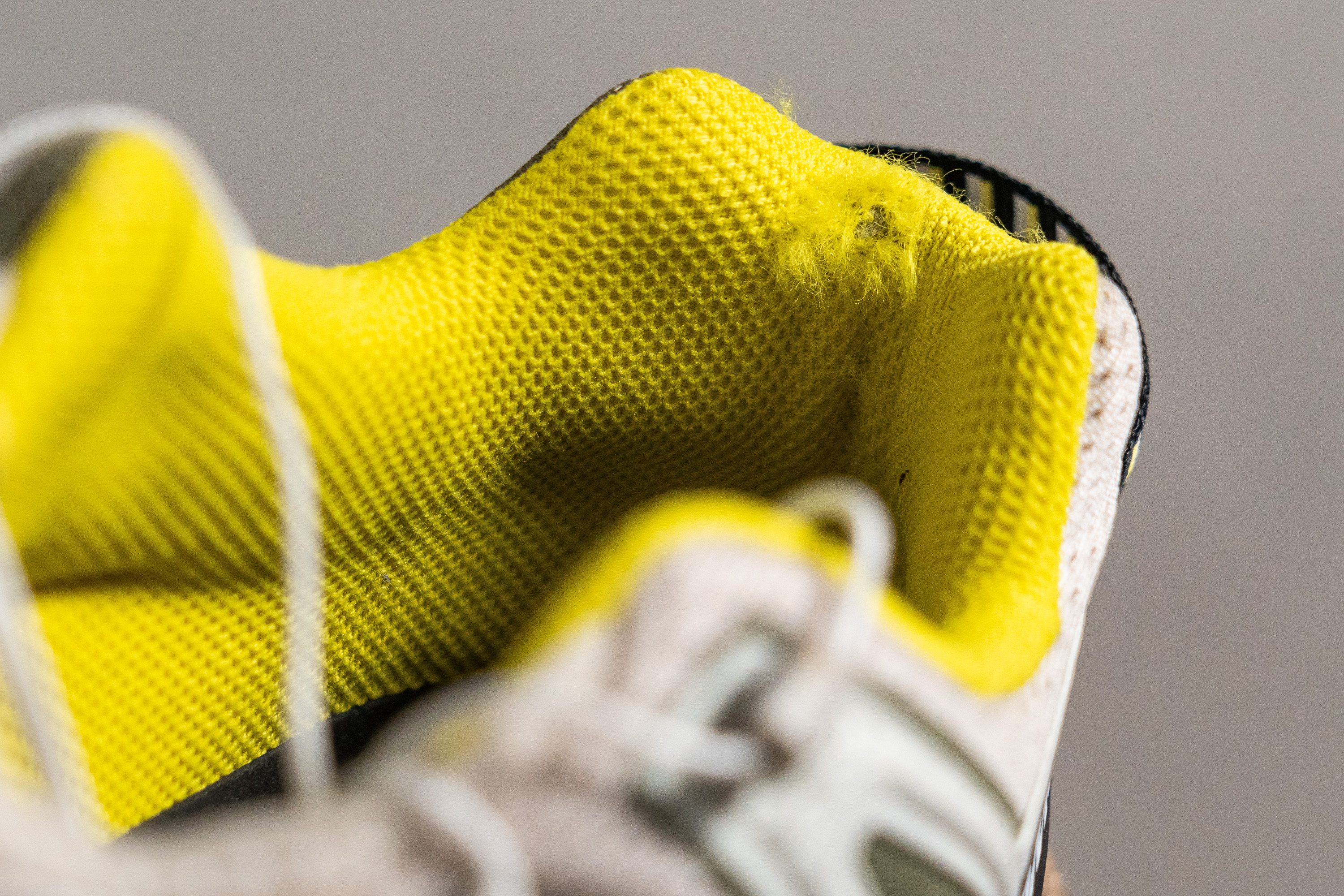
| XA Pro 3D v9 | 2 |
| Average | 3 |
Outsole hardness
Pressing our durometer against the XA Pro 3D v9's ContraGrip outsole yields a reading of 83.1 HC which is right around our current lab average.
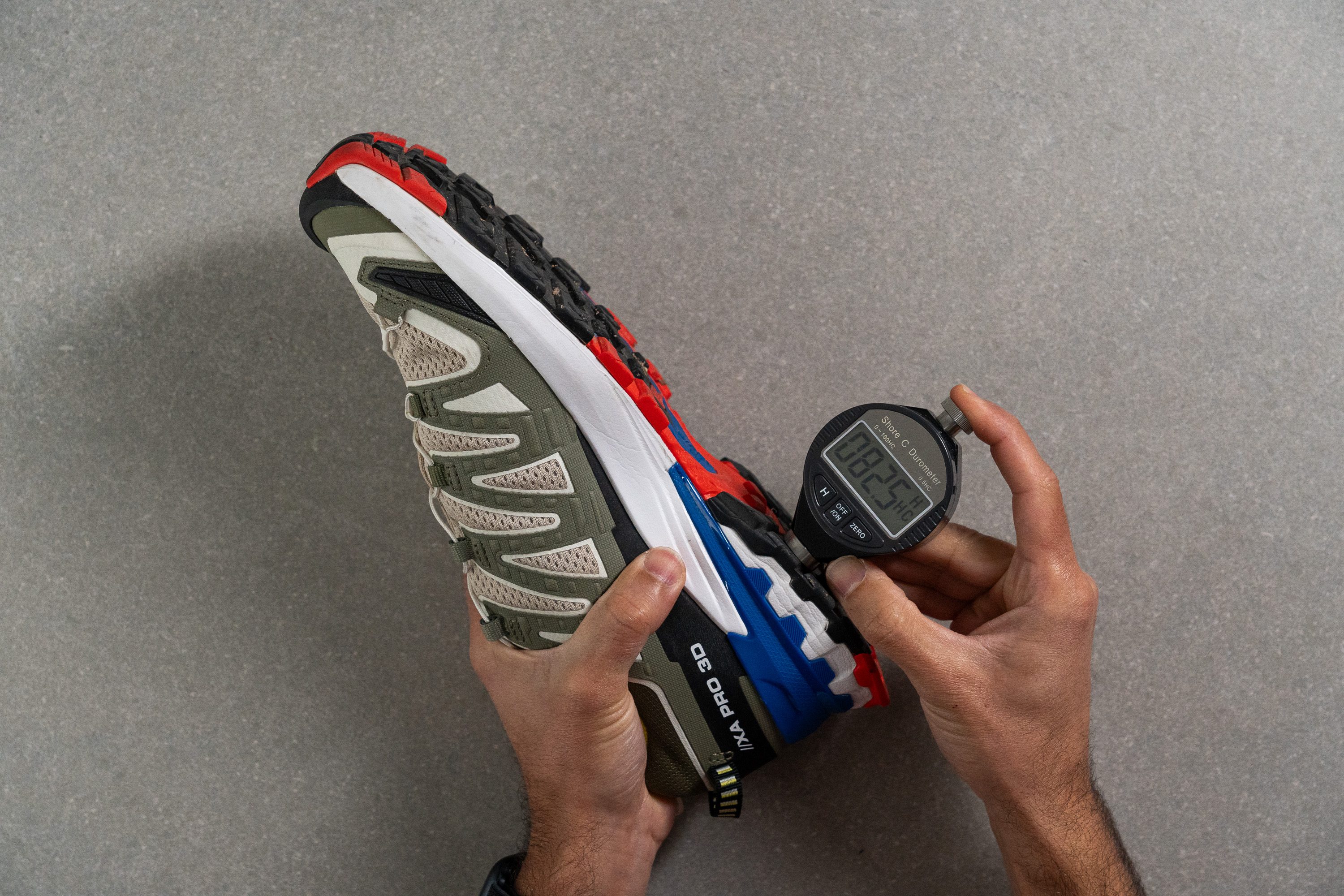
| XA Pro 3D v9 | 83.1 HC |
| Average | 85.8 HC |
Outsole durability
For its final appearance, this time spinning at 10K RPM, we set our Dremel against one of the XA Pro 3D v9's outsole lugs. After a bit of a rocky start, the tool settles in but seems to have little effect on the shoe.
After twenty-two seconds of grinding, we used a tire tread gauge to measure the damage and found that the tool actually managed to shear away 0.8 mm of rubber off the lug. This is similar to how much the average trail shoe loses in this test, leading us to predict that it should take at least 400 miles of normal use before any notable signs of wear and tear, and even longer before losing enough of the lug to compromise traction.
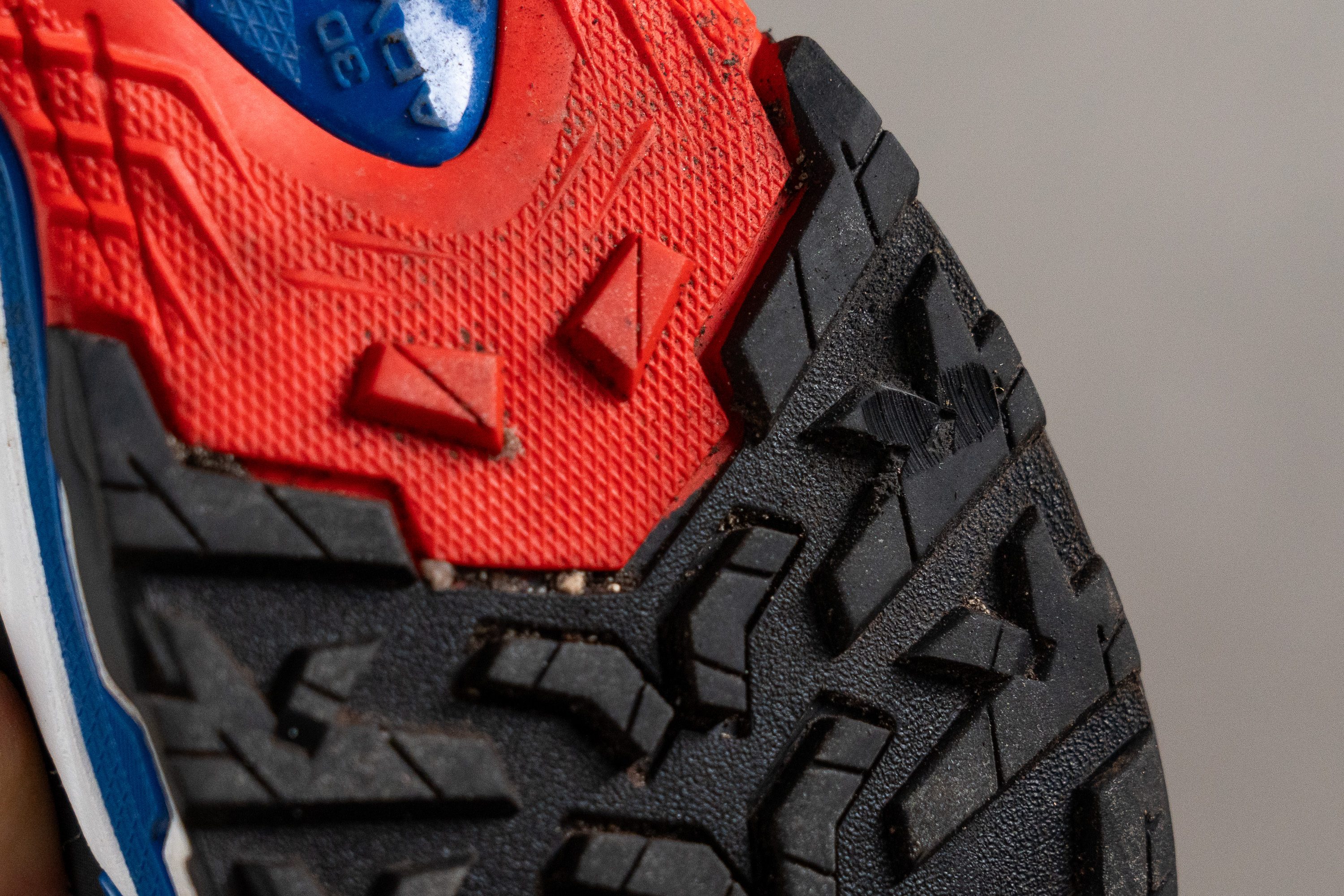
| XA Pro 3D v9 | 0.8 mm |
| Average | 0.9 mm |
Outsole thickness
At 3 mm thick according to our caliper measurements, the XA Pro 3D v9 has an average amount of rubber in the outsole.
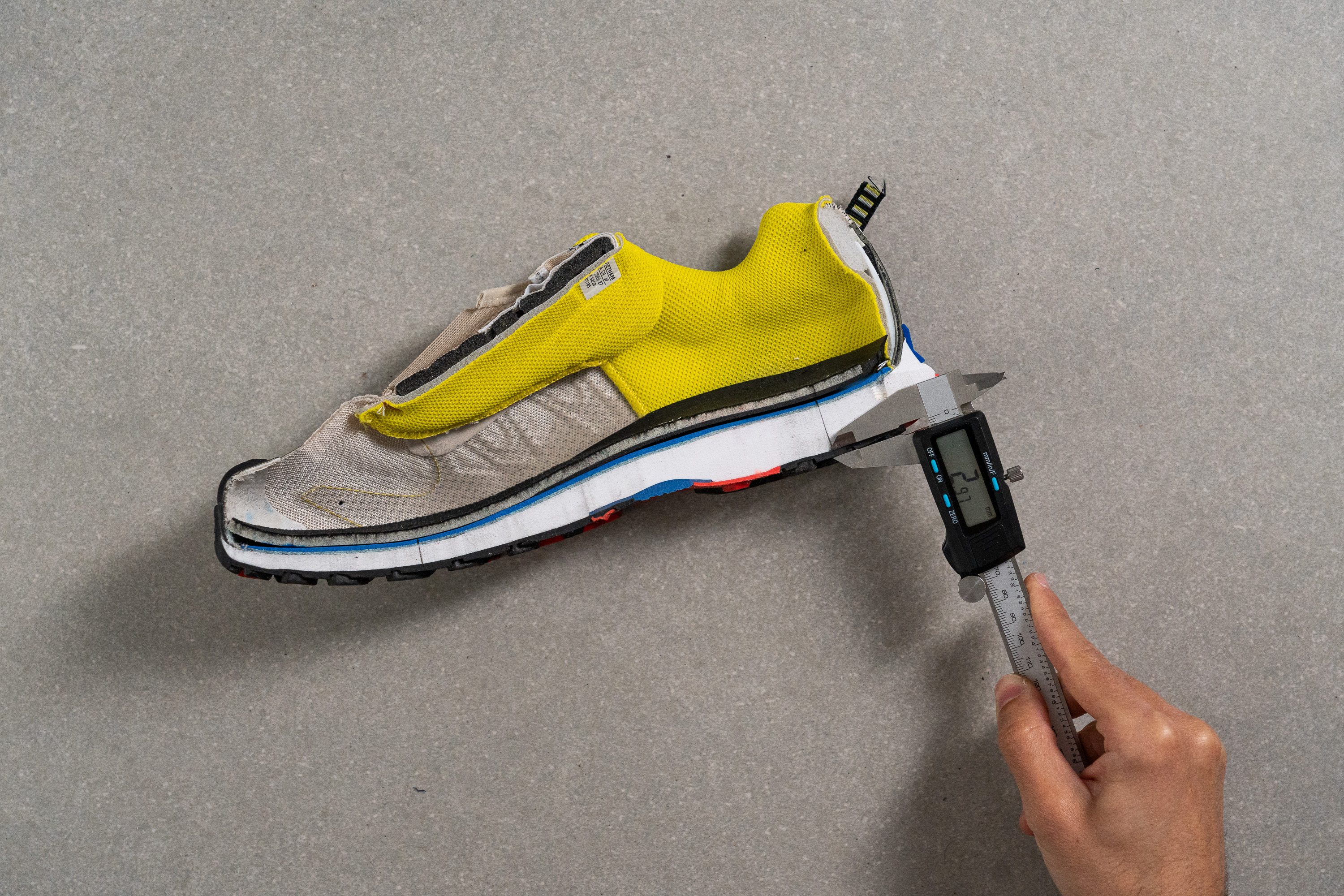
| XA Pro 3D v9 | 3.0 mm |
| Average | 2.2 mm |
Misc
Insole thickness
At 4.9 mm thick, the XA Pro 3D v9's insole is on par with our current lab average and provides us with good arch support and a cushy footbed that nicely complements the midsole cushioning.
| XA Pro 3D v9 | 4.9 mm |
| Average | 4.7 mm |
Removable insole
The XA Pro 3D v9's insole is removable so replacing it with an aftermarket one or a custom orthotic is possible if necessary.
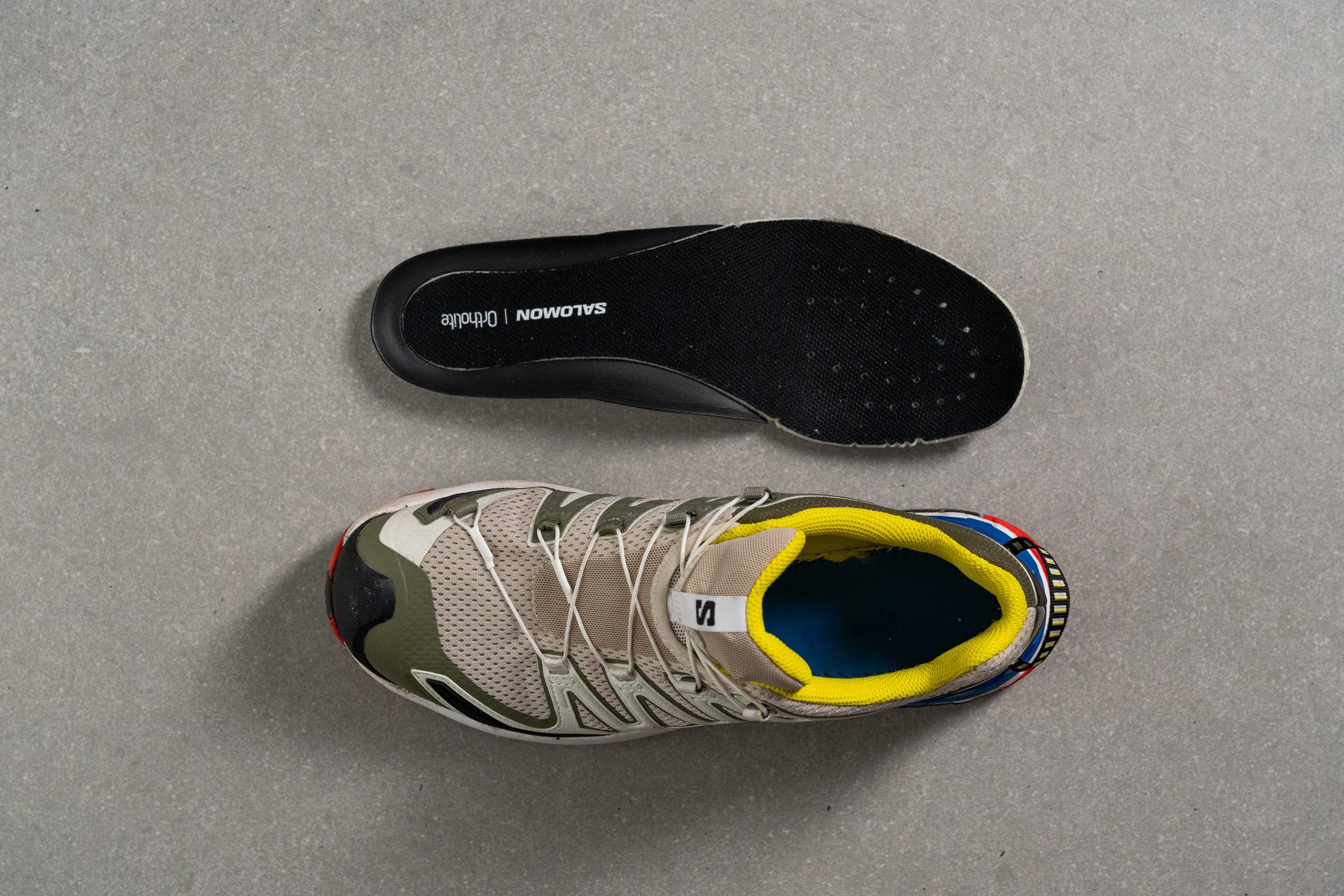
| XA Pro 3D v9 | Yes |
Midsole softness in cold (%)
To test the effects of cold conditions on the midsole, we placed the XA Pro 3D v9 in the freezer for twenty minutes. Once sufficiently chilled, we took another durometer reading of the midsole and found that it only became 14.5% firmer than at room temperature. While this is still rather firm, the shoe's cushioning won't feel too different whether soaking in the sun in the summertime or challenging the elements in the winter. That said, we don't necessarily recommend this shoe as the ideal winter trainer as we'll discuss in our next freezer section.
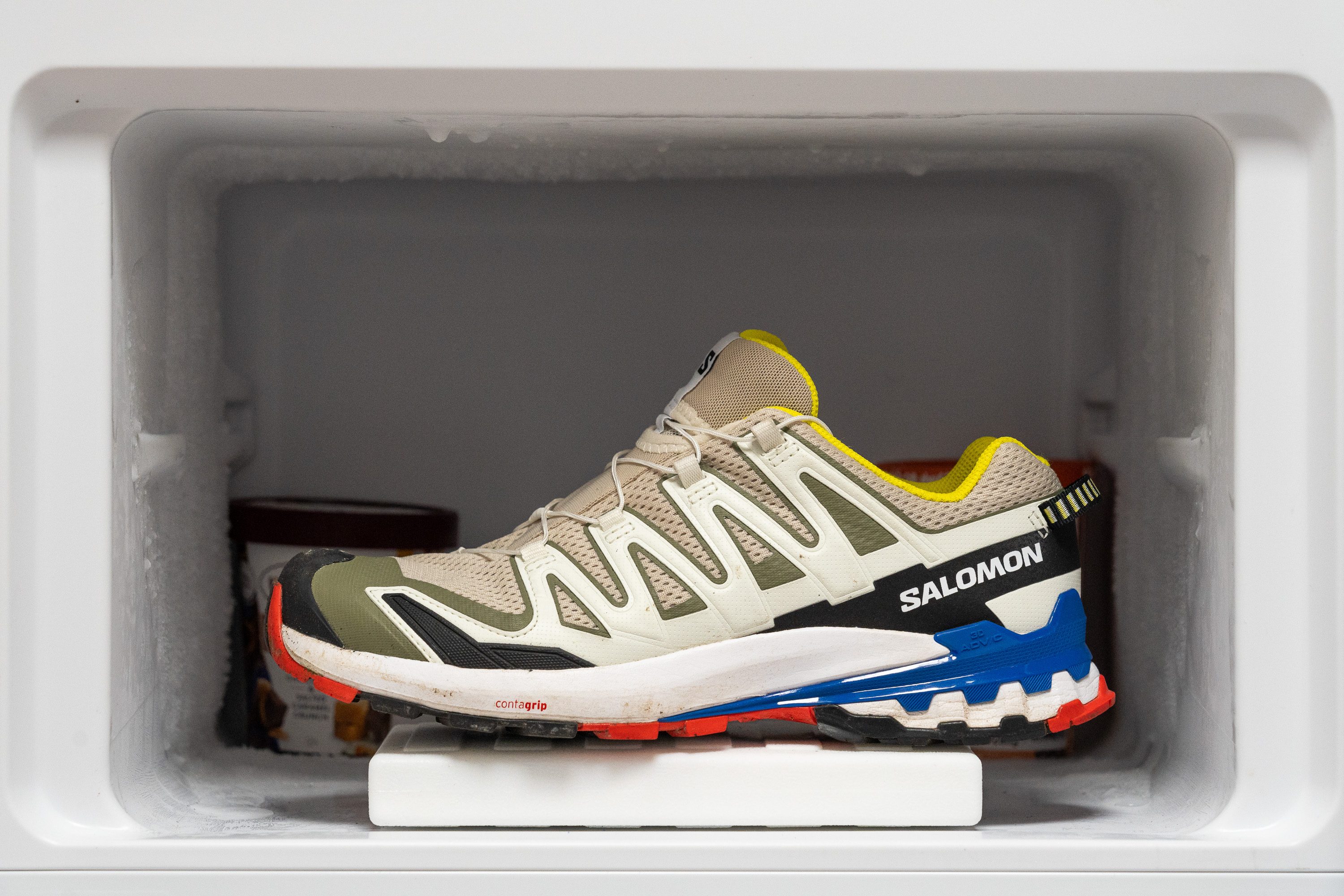
| XA Pro 3D v9 | 15% |
| Average | 26% |
Reflective elements
The XA Pro 3D v9 doesn't feature any reflective elements whatsoever. We, therefore, don't recommend running alongside dimly lit roads without any additional high-vis gear.
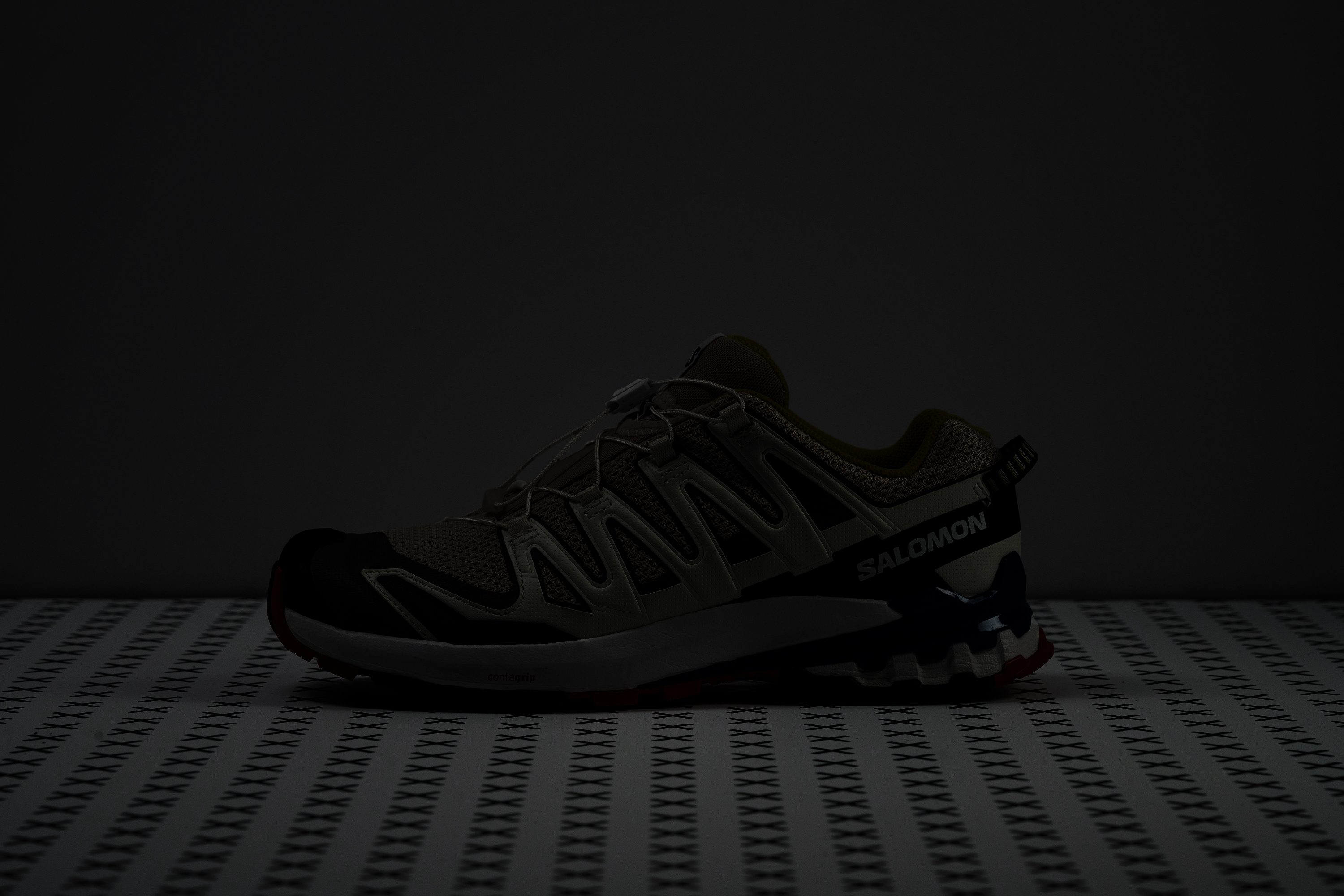
| XA Pro 3D v9 | No |
Tongue padding
Using our caliper, we measured the XA Pro 3D v9's tongue to be 9.8 mm thick, making it quite a bit chunkier than our current lab average. This translates to an incredibly comfy and secure midfoot lockdown that pampers our feet while keeping us safe from lace bite.
| XA Pro 3D v9 | 9.8 mm |
| Average | 6.4 mm |
Tongue: gusset type
The XA Pro 3D v9's tongue isn't gusseted in a traditional sense but sits within a mesh pocket beneath the laces. This does mitigate how much debris is able to enter the shoe while but doesn't do much to keep the tongue from sliding off to the side during our test runs, especially if not laced up tight. As such, we weren't fully immune to the occasional twig or bit of grit making their way into the shoe.
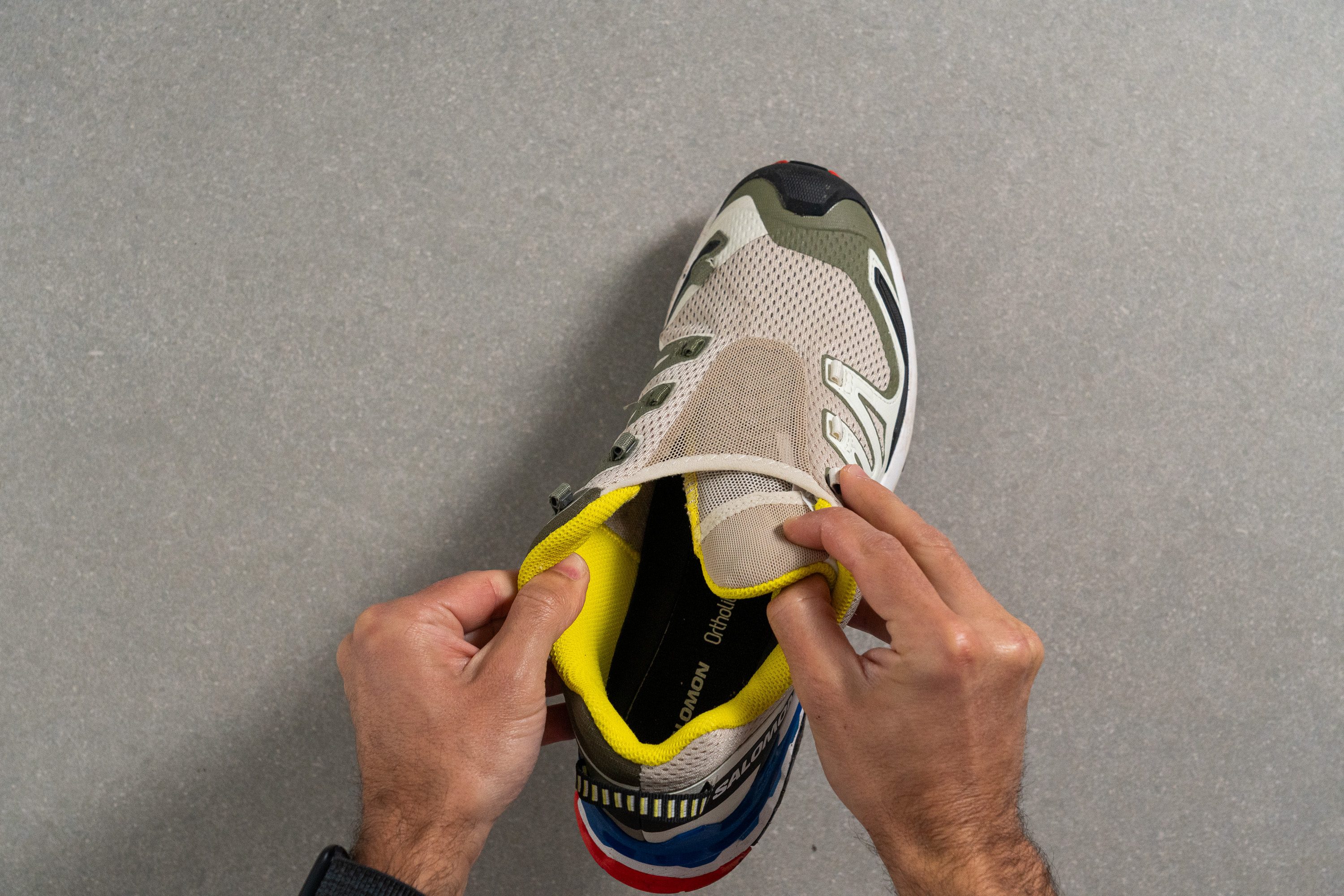
| XA Pro 3D v9 | None |
Heel tab
There's a handy little strap running across the XA Pro 3D v9's heel counter which is easy to grab and makes sliding the shoe on a little easier. Not to mention, it looks a lot cooler than most traditional finger loops.
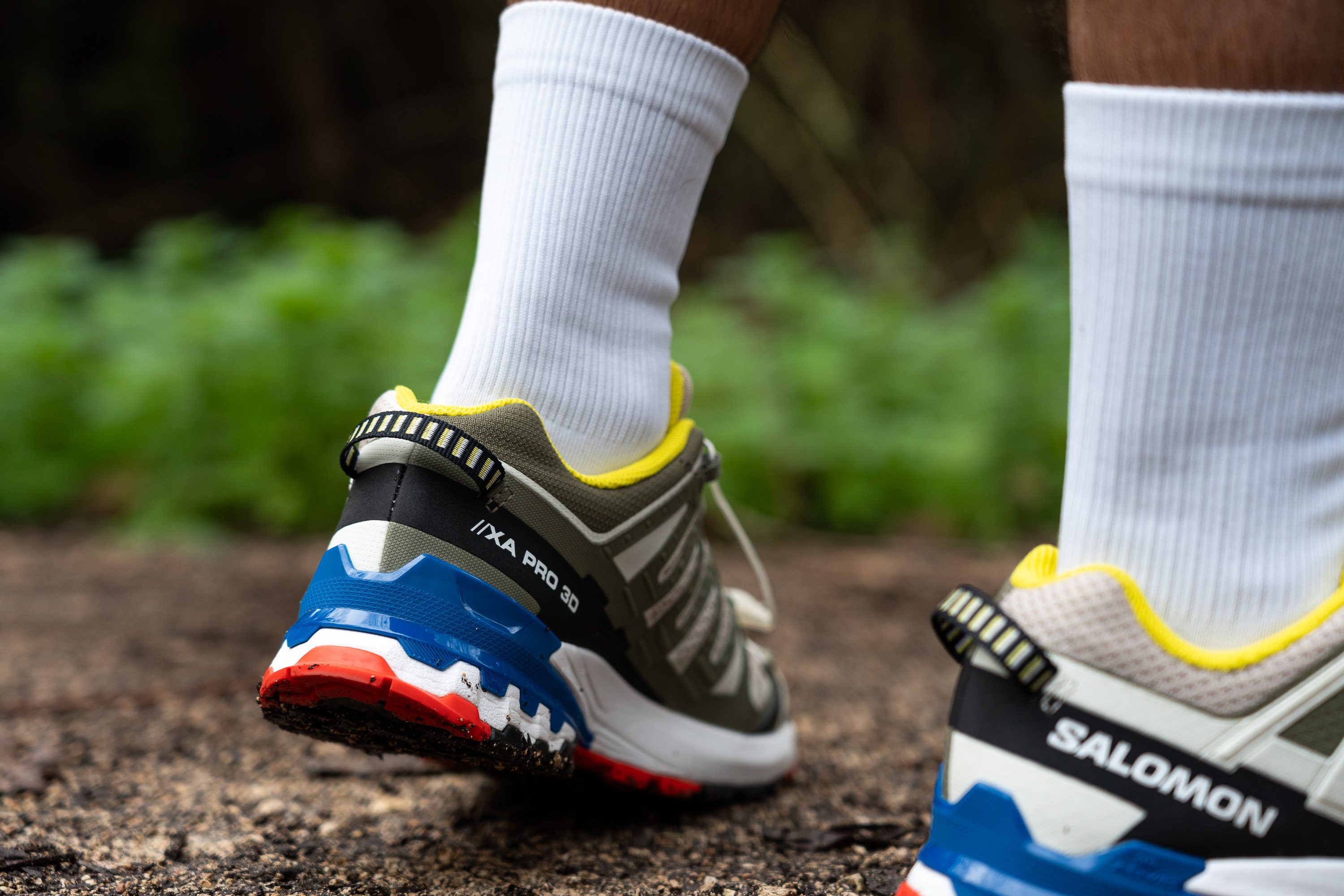
| XA Pro 3D v9 | Finger loop |













































